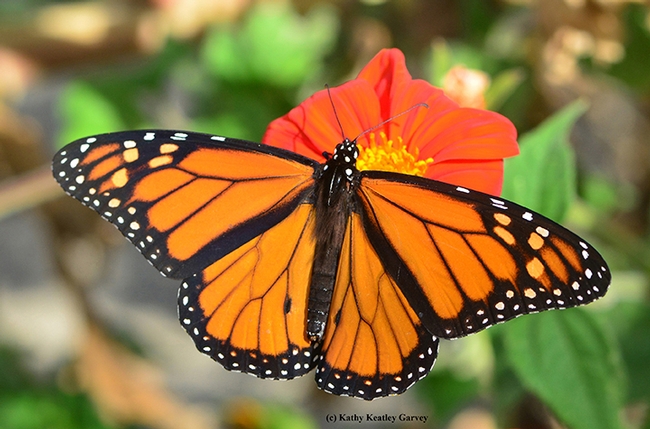
The more we know about monarch butterflies, the better we can understand them and help conserve them.
Newly published research on California's overwintering monarch butterflies (Danaus plexippus) confirmed many previous migratory studies, but found some unexpected and surprising patterns of movement, said lead researcher Louie Yang, a community ecologist with the UC Davis Department of Entomology and Nematology.
The study, “Intra-Population Variation in the Natal Origins and Wing Morphology of Overwintering Western Monarch Butterflies (Danaus plexippus)," published in the early online version of the journal Ecography, examined the natal origins, or “birthplaces,” of butterflies at four California overwintering sites.
It will be incorporated into an online issue, perhaps within six months, but it has not yet been assigned to an issue, said journal managing editor Maria Persson.
Natal origins of butterflies collected from the two northern sites--Lighthouse Field State Beach and Moran Lake, both in Santa Cruz County--varied significantly from those collected at the two southern overwintering sites--Pismo State Beach, San Luis Obispo County; and the Coronado Butterfly Preserve, Santa Barbara County, they said.
“We hope that this paper improves our understanding of where monarch butterflies grow up in western North America,” said Yang, an associate professor. “This study uses a naturally occurring continental-scale pattern of hydrogen isotopes in precipitation in order to estimate the natal origins of overwintering butterflies. Building a clearer understanding of where they come from could help us better understand many aspects of their ecology.”
The research is the work of Yang; Dmitry Ostrovsky of the University of Colorado, Denver; and Matthew Rogers and Jeffery Welker of the University of Alaska.
The research team set out to answer two key questions: “How do broad geographic areas of potential natal habitat contribute to the overwintering population of western monarch butterflies in California?” and “How does the individual variation in the wing morphology of overwintering western monarch butterflies correlate with estimated migratory distance from their natal origins?”
They first compared the wings of 114 monarch butterflies collected from the four overwintering sites with a continental-scale monarch butterfly wing isoscape derived from the U.S. Network for Isotypes in Precipitation (USNIP) database. They used spatial analyses of stable isotype ratios and correlations with wing morphology. Then they examined the correlations of monarch butterfly forewing size and shape.
Of the 114 butterflies sampled, they found that 30 percent developed in the southern coastal range; 12 percent in the northern coast and inland range; 16 percent in the central range, and 40 percent developed in the northern inland range.
“Interestingly, the two most northern overwintering sites in the study showed the largest contributions from the southern coastal range (Lighthouse Field, 45 percent; Moran Lake, 37 percent; Pismo Beach, 22 percent; and Coronado Preserve, 24 percent) while the two most southern overwintering sites showed the largest contributions from the northern inland range (Lighthouse Field, 30 percent; Moran Lake, 35 percent; Pismo Beach, 53 percent; and Coronado Reserve, 39 percent),” they wrote.
The researchers randomly collected the monarchs Dec. 4-6, 2009 from aggregations in trees. The collecting resulted in: 19 males and 9 females from Coronado; 22 males and 8 females from Pismo State Beach; 20 males and 10 females from Moran Lake; and 18 males and 8 females from the Lighthouse Field State Beach.
In addition, the male monarch butterflies showed mean total masses that were 5.8 percent larger than those of the females.
The monarch butterfly of North America overwinters along the California coast and in the central mountains of Mexico. Previous studies have indicated that the western monarchs or those from natal habitats west of the Rocky Mountains, overwinter along the California coast. Those that develop east of the Rockies overwinter in central Mexico.
The project was funded in part by a National Science Foundation (NSF) Early Career Development Program grant awarded to Louie Yang, and a NSF Major Research Instrumentation Program grant awarded to Jeffrey Welker.
(Note: For more information on monarchs, read the Xerces Society's website. Xerces also encourages us all to plant milkweed. See Project Milkweed.)
Attached Images:


